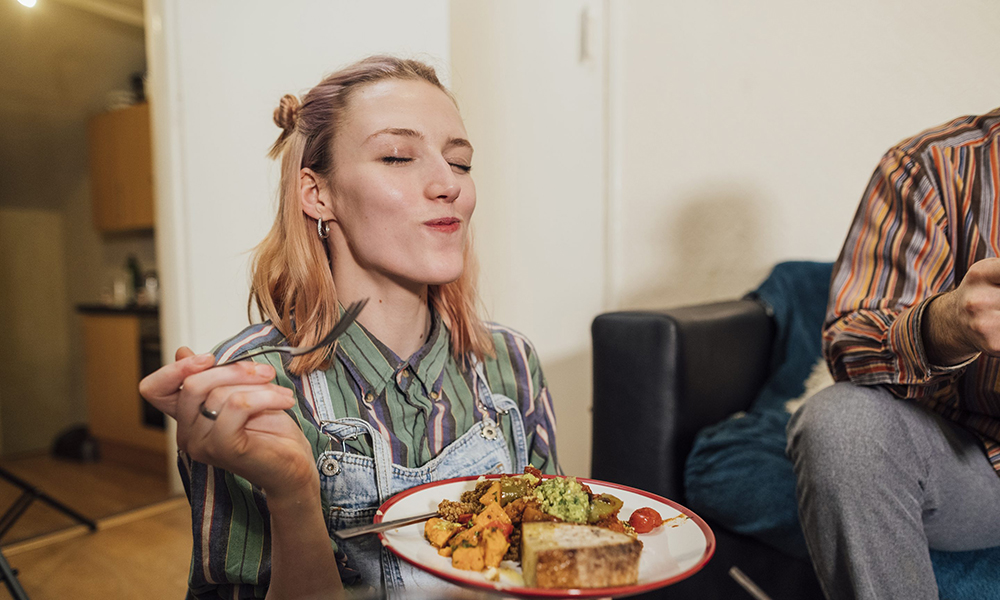
連鎖沙拉店Sweetgreen將在其菜單中增加牛排。這則消息在網上引起了激烈反響,顧客紛紛質疑這會對該公司的碳中和計劃產生哪些影響。
創建于2007年的Sweetgreen是一家供應沙拉和素食碗的快速休閑餐廳,聲稱將于2027年實現碳中和,這意味著它計劃執行策略抵消自身的碳排放,同時減少大氣中的碳排放。
但牛肉生產需要消耗大量資源,是導致氣候變化的原因之一。牛肉生產是全球最大的農業溫室氣體排放源,這個過程會向大氣排放大量甲烷,而且需要使用大量土地。
Sweetgreen上周宣布在菜單中添加香煎咖喱牛排,這一爭議舉動背后的理由包括使用再生農業。該連鎖餐廳還表示,碳抵消是其應對氣候變化和減少溫室氣體排放這一承諾的一部分。
Sweetgreen在回應置評請求時,建議參考關于增加菜單的詳細通告。什么是再生農業?
密歇根州立大學再生農業中心(Michigan State University Center for Regenerative Agriculture)的聯席主任賈森·朗特里稱,再生農業是指耕種和飼養牲畜不僅能夠從自然環境中收獲農產品,還可以改善生態環境。
朗特里指出,這意味著“盡量減少干擾,保持地面覆蓋”,并且“通過在耕種系統中增加動物或增強地下生物,改善地下和地上的生物多樣性”。
許多食品雜貨連鎖店和餐廳開始選擇通過再生農業獲得動物蛋白、谷物、水果和蔬菜,同時實現氣候目標。星巴克(Starbucks)將再生農業作為到2030年減少一半的碳排放、用水和浪費的一種方法。Chipotle和漢堡王(Burger King)也開始涉足再生農業。
農業咨詢公司Understanding Ag的創始人、農民艾倫·威廉姆斯說:“關鍵在于你做了什么以及如何落實。再生農業能夠修復、重建和恢復我們的生態系統——如果我們想要減緩氣候變化,再生農業將至關重要。”
有專家質疑再生農業能否抵消牛肉生產產生的所有排放。什么是碳抵消?
各行各業的公司,包括餐飲公司,都在購買碳抵消額度。它們購買“碳信用額度”,信用額度是一個自愿的、不受監管的市場的一部分,適用于聲稱可吸收本來可能產生的二氧化碳排放的項目。
碳抵消的目的是抵消自身的二氧化碳污染。但這并不是一門精準的科學。
氣候非營利組織Project Drawdown的執行總監喬納森·弗利表示,雖然Sweetgreen等公司的努力值得稱贊,但“眾所周知,毫不夸張地說,過去幾年碳抵消確實存在問題”。有哪些其他解決方案?
即使一家連鎖店采用富有成效的再生農業和碳抵消,專家們認為它使用塑料、紙張或不可再生能源,會讓這些努力付諸流水。
因此,專家們認為,當務之急應該是關注連鎖餐廳的整體碳足跡,培養和改善對食品安全更有韌性的局面,并改善水循環。
朗特里說:“歸根結底,我認為干旱以及長期干旱之后的強降雨,可能是未來農業面臨的最大挑戰。”(財富中文網)
譯者:劉進龍
審校:汪皓
連鎖沙拉店Sweetgreen將在其菜單中增加牛排。這則消息在網上引起了激烈反響,顧客紛紛質疑這會對該公司的碳中和計劃產生哪些影響。
創建于2007年的Sweetgreen是一家供應沙拉和素食碗的快速休閑餐廳,聲稱將于2027年實現碳中和,這意味著它計劃執行策略抵消自身的碳排放,同時減少大氣中的碳排放。
但牛肉生產需要消耗大量資源,是導致氣候變化的原因之一。牛肉生產是全球最大的農業溫室氣體排放源,這個過程會向大氣排放大量甲烷,而且需要使用大量土地。
Sweetgreen上周宣布在菜單中添加香煎咖喱牛排,這一爭議舉動背后的理由包括使用再生農業。該連鎖餐廳還表示,碳抵消是其應對氣候變化和減少溫室氣體排放這一承諾的一部分。
Sweetgreen在回應置評請求時,建議參考關于增加菜單的詳細通告。什么是再生農業?
密歇根州立大學再生農業中心(Michigan State University Center for Regenerative Agriculture)的聯席主任賈森·朗特里稱,再生農業是指耕種和飼養牲畜不僅能夠從自然環境中收獲農產品,還可以改善生態環境。
朗特里指出,這意味著“盡量減少干擾,保持地面覆蓋”,并且“通過在耕種系統中增加動物或增強地下生物,改善地下和地上的生物多樣性”。
許多食品雜貨連鎖店和餐廳開始選擇通過再生農業獲得動物蛋白、谷物、水果和蔬菜,同時實現氣候目標。星巴克(Starbucks)將再生農業作為到2030年減少一半的碳排放、用水和浪費的一種方法。Chipotle和漢堡王(Burger King)也開始涉足再生農業。
農業咨詢公司Understanding Ag的創始人、農民艾倫·威廉姆斯說:“關鍵在于你做了什么以及如何落實。再生農業能夠修復、重建和恢復我們的生態系統——如果我們想要減緩氣候變化,再生農業將至關重要。”
有專家質疑再生農業能否抵消牛肉生產產生的所有排放。什么是碳抵消?
各行各業的公司,包括餐飲公司,都在購買碳抵消額度。它們購買“碳信用額度”,信用額度是一個自愿的、不受監管的市場的一部分,適用于聲稱可吸收本來可能產生的二氧化碳排放的項目。
碳抵消的目的是抵消自身的二氧化碳污染。但這并不是一門精準的科學。
氣候非營利組織Project Drawdown的執行總監喬納森·弗利表示,雖然Sweetgreen等公司的努力值得稱贊,但“眾所周知,毫不夸張地說,過去幾年碳抵消確實存在問題”。有哪些其他解決方案?
即使一家連鎖店采用富有成效的再生農業和碳抵消,專家們認為它使用塑料、紙張或不可再生能源,會讓這些努力付諸流水。
因此,專家們認為,當務之急應該是關注連鎖餐廳的整體碳足跡,培養和改善對食品安全更有韌性的局面,并改善水循環。
朗特里說:“歸根結底,我認為干旱以及長期干旱之后的強降雨,可能是未來農業面臨的最大挑戰。”(財富中文網)
譯者:劉進龍
審校:汪皓
Salad chain Sweetgreen is adding steak to its menu, an announcement that led to strong reactions online, with customers questioning how that would impact the company’s carbon neutral plans.
Founded in 2007 and known as a fast-casual spot serving salads and bowls, Sweetgreen says it will be carbon neutral by 2027 — meaning it plans to offset its own emissions by putting in place strategies that also remove carbon from the atmosphere.
But beef production is incredibly resource-intensive and a contributor to climate change. It’s the largest agricultural source of greenhouse gases globally, emitting massive amounts of methane into the atmosphere, and requires extensive land use.
Sweetgreen’s rationale for the controversial caramelized, garlic-flavored steak menu addition last week includes using regenerative farming. The chain also says carbon offsets are part of its pledge to combat climate change and reduce its greenhouse gas emissions.
A Sweetgreen spokesperson referred request for comment to its menu expansion details.What is regenerative agriculture?
Regenerative agriculture means farming and ranching in a way that not only produces food from a landscape, but also sees that landscape improve ecologically, said Jason Rowntree, co-director of the Michigan State University Center for Regenerative Agriculture.
This means “minimizing disturbance, keeping ground covered,” Rowntree said, “improving biodiversity below and above ground through adding animals to your cropping systems or enhancing biology below ground.”
Many grocery chains and restaurants are starting to look to regenerative agriculture for animal proteins, grains and fruits and vegetables while meeting climate goals. Starbucks cited regenerative agriculture as one way it aims to slash its carbon, water use and waste in half by 2030. Chipotle and Burger King have also dabbled in it.
“It’s all in what you do and how you implement it,” said Allen Williams, a farmer and founder of agriculture consultancy Understanding Ag. “It allows for the repair, rebuilding and restoration of our ecosystems — and that’s critically important if we want to mitigate climate change.”
Some experts question whether regenerative agriculture can offset all emissions from beef production in particular. What are carbon offsets?
Companies, including those in dining, also buy carbon offsets. They purchase “credits,” as part of a voluntary and unregulated market for projects that claim to absorb carbon dioxide that otherwise would’ve happened.
These offsets are an effort to cancel out one’s own carbon dioxide pollution. But it isn’t an exact science.
Though companies including Sweetgreen should be applauded for their efforts, “We all know that the offsets schemes over the last few years have been really problematic, to say the least,” said Jonathan Foley, executive director of climate nonprofit Project Drawdown. What can be done instead?
Even if a chain employs productive regenerative agriculture and offsets, experts say its use of plastic, paper or non-renewable energy could negate those practices.
So the priority should be focusing on a restaurant chain’s whole carbon footprint, fostering and improving landscapes that are more resilient for food security and improving water cycling, experts say.
“At the end of the day,” Rowntree said, “I think these challenges we’re going to see with aridity, with heightened intensity of rain events followed by longer periods of drought are probably agriculture’s biggest challenge moving forward.”






